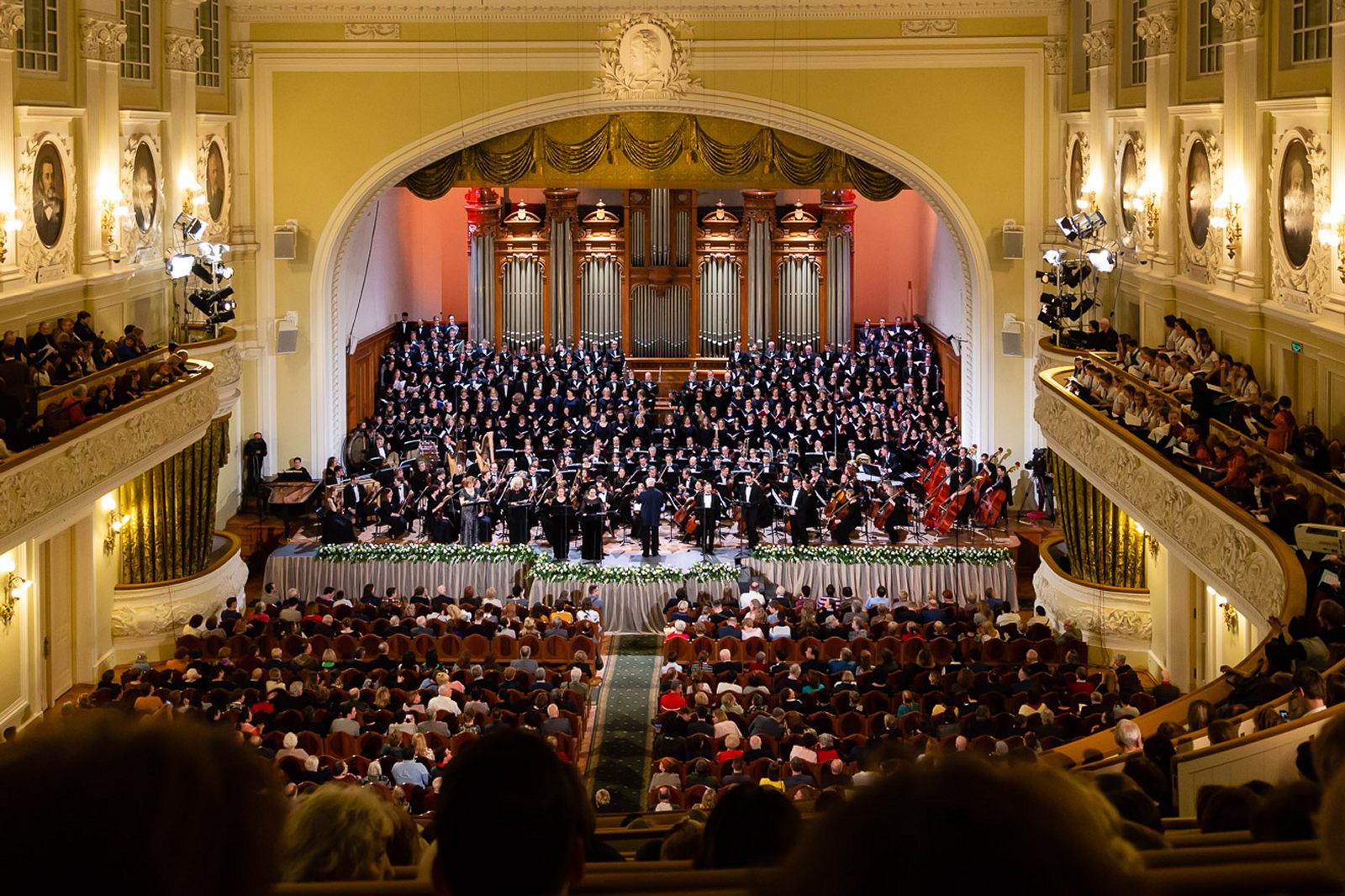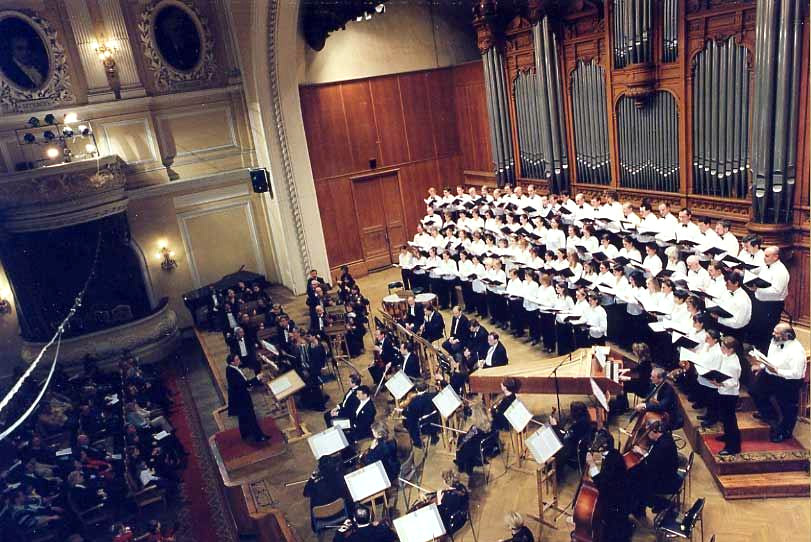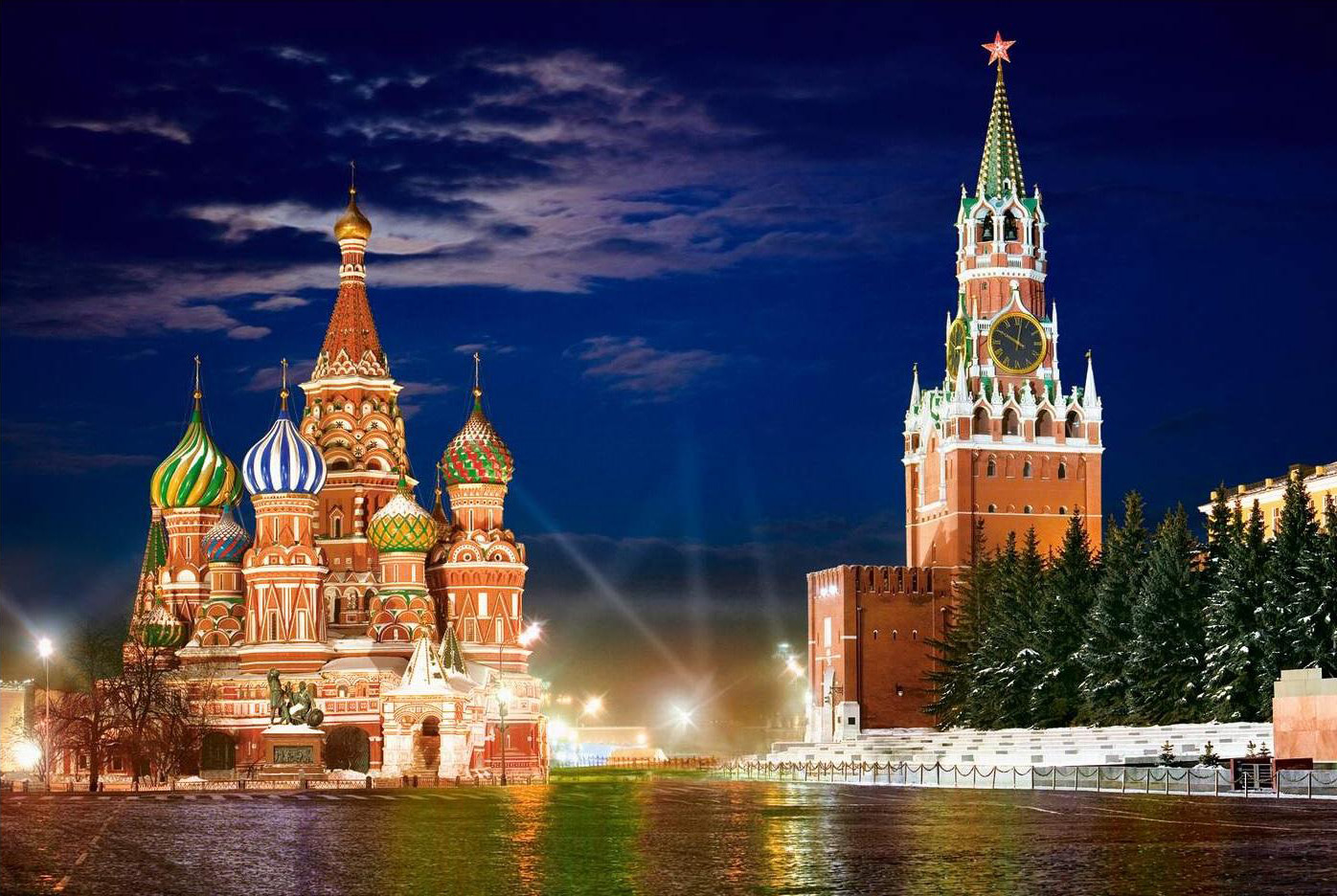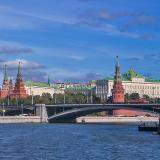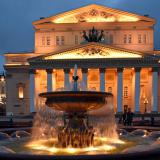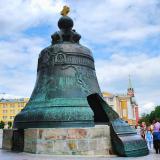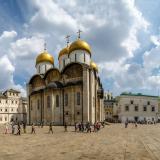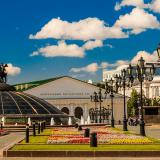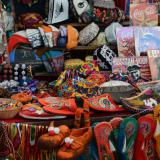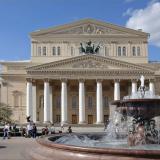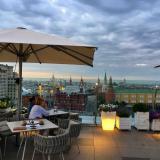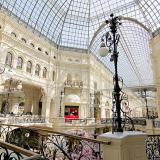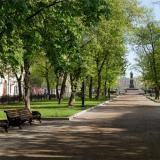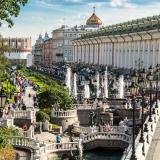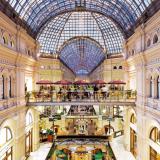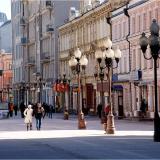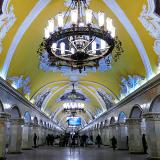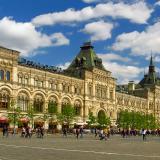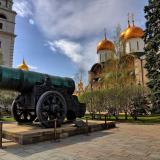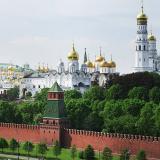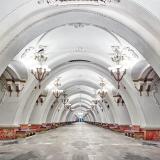Main places
Moscow Kremlin
Many people are unaware that there is more than one kremlin in Russia - after all, "kremlin" is the Russian word for a fortress in the centre of a city. However, the Moscow Kremlin is unique: far more than a fortress, it is the historical heart of Moscow, and the spiritual and political centre of Russia. Every period of the country’s history over the last 500 years is represented here, from the 15th century walls and magnificent 16th- and 17th- century cathedrals to the grand 18th- and 19th- century palaces, and the huge Soviet-era Palace of Congresses. Many of Russia’s greatest leaders have made their contributions to the Kremlin’s architecture and history, including Ivan the Terrible, Mikhail Romanov, Peter the Great, Catherine the Great and Alexander I. The Moscow Kremlin is a UNESCO World Heritage Site and the official residence of the President of the Russian Federation. We invite visitors on a sightseeing tour around the capital’s number one attraction.
Within the walls of the Kremlin you will find many fascinating and unique sights:
-
Assumption Cathedral - Russian rulers were crowned and married here; and generations of tsars are buried in the burial vault of the Archangel Cathedral.
-
The monumental Grand Kremlin Palace - used as a venue for official ceremonies.
-
The Senate - another fine construction, which in its time has welcomed many famous statesmen and formerly housed the Imperial Senate. After the Revolution Lenin had his office here.
-
The Tsar Cannon and Tsar Bell, the heaviest bell and largest cannon in the world, both extraordinary examples of Russian bronze casting.
-
The Arsenal, a rare example of a military building from the time of Peter the Great, which remains in use. Along the wall of the Arsenal there are many of the cannon that were captured from Napoleon’s Army as it retreated from Russia.
You will learn about the Kremlin’s rich history and its role in Russia’s history over eight centuries. This unique ensemble of majestic buildings is guaranteed to make a lasting impression!
The Armory Chamber
Upon hearing the word "armory", it is easy to become excited, especially for those with a keen interest in weapons and war. As the name implies, originally, the Armory was created to serve solely as a weapons store. Later, by decree of Peter the Great, it was decided that extremely valuable and rare items were to be transferred to this marvelous museum. Now, the Armory is teeming with awesome artefacts; so much more than a simple collection of antique weapons! You will be awestruck by the ancient state regalia, items from the royal household such as carriages, clothing and silverware, as well as the world-famous Fabergé eggs, crowns and much more! We are excited to invite you on a tour where almost every exhibit is steeped in legend! Feast your eyes!
Here you will find exhibits, which simply cannot be missed:
-
Monomakh's legendary cap, a breathtaking symbol of autocratic power Russia
-
Minin and Pozharsky’s famous sword
-
The legend Dobrynya Nikitich’s armour
-
Tsarina Catherine the Great’s beautiful coronation dress
-
The young princes Ivan and Peter’s specially made double throne.
It is simply impossible to list all the interesting exhibits of the Armory in such a short description but rest assured, you are in for a hearty and enriching experience. Amongst other things, you will take in: an extensive and jaw-droopingly beautiful collection of silver and gold jewelers, ceremonial weapons, precious fabrics, and even ceremonial horse harnesses.
The Diamond Fund
The Diamond Fund is not only a unique museum displaying a stunning exhibition of historical artifacts, jewelers and precious stones, but also the main treasury of the Russian Federation. The dazzling beauty of the jewelers exhibited here is indescribable. With jaw-dropping diamonds and sparkling emeralds, this collection is unrivalled the world over. We proudly invite you to visit one of the most ambitious projects in our country’s history!
Today, it seems incredible that this fantastic collection began as just a small wrought iron chest that Peter the Great instructed the royal jewels and state regalia be kept in. It is very doubtful that 300 years ago, Peter would have foreseen that his rather modest collection would turn into this mega-project, comparable to the Crown Jewels at the Tower of London.
On the tour you will see:
-
Invaluable historical exhibits: coronation ceremony instruments (orb, scepter, crown), insignia, items specially made for the members of the imperial house, the jewelers of Russian kings and queens (tiaras, earrings, brooches, hair clips etc.).
-
The Russian monarchs’ power symbols - the Imperial Crown of Russia, a work of art made up of diamonds and pearls, topped with a rare red spinel.
-
Jewelers made of precious metals and stones, created in Soviet times by outstanding master craftsmen, especially for the Diamond Fund.
-
‘Seven Wonders of the Diamond Fund’ - a legendary exhibition of gems, including diamonds and other stones of epic proportions.
-
The collection of platinum and gold nuggets, the largest of which is called the ‘Big Triangle’ and weighs a whopping 36kg!
However, the Diamond Fund should not only be assessed by its astronomical value. The Fund is priceless because every historical exhibit found here is a unique artefact, and the delicate art of the master jewelers defies the craftsmanship of Mother Nature herself!
Red Square and the Alexander Gardens
There is a well-known saying that "all roads lead to Rome”, and, in Russia, it is still very much the case that "all roads lead to Moscow", and to Red Square, in the very centre of the city. After all, the roads in this enormous country are measured from Zero kilometer, right in front of the main entrance to the square. But Red Square is more than just the geographical centre of Moscow; it is the city’s living heart. It may not be the biggest urban square in the world - it measures just 330 meters by 75 meters - but you can feel history here in every stone. There are many tourist routes through old Moscow, but an excursion around Red Square and the Alexander Gardens should definitely be at the top of the list. Here you can feel Russia’s pulse, be transported through its history and appreciate its values. Red Square and the Alexander Gardens welcome you with open arms!
-
You will be able to explore Russia’s central square, and admire all its spectacular monuments, each of which has a long history about which entire books could be written: the Kremlin wall and the Spasskaya Tower - with the most famous clock in Russia, the jewel-like Kazan Church, the unique Cathedral of Saint Basil the Blessed-known throughout the world as a symbol of Russia, Lenin’s mausoleum - a masterpiece of Constructivist design, the elaborate State Historical Museum and GUM - the famous 19th-century department store.
-
You will walk over the square’s Crimean dolerite cobblestones to the sinister Lobnoye Mesto, and visit the Alexander Garden, dedicated to Russia’s victory over Napoleon. There you will be able to see the Tomb of the Unknown Soldier and watch the ceremony of the changing of the guard. You will also be able to stand on the Zero kilometer point and make a wish.
-
Our guide will tell you many interesting stories about everyday life in past centuries, major historical events and famous historical figures, ancient folk tales, legends, mysteries and secrets – everything you have always wanted to know about the city’s past and present.
A walking tour of Red Square and Alexander Garden is a fascinating journey through Moscow’s, and Russia’s, history, full of bright impressions and emotions.
Red Square and St. Basil's Cathedral
Red Square, in the very centre of the city, is definitely number one on any visitor’s list of things to see and do in Moscow. Together with the Kremlin, it forms the most important of the city’s three UNESCO World Heritage Sites, and is, quite rightly, one of the most famous city squares in the world. The history of Red Square goes hand in hand with that of the Kremlin - when the stone walls were built around the Kremlin in the 1490s the builders decided to leave an open area to the east of the Kremlin wall so that attackers would have no cover if they decided to attack the Kremlin from that direction. This big open area soon became a marketplace, a place for public gatherings, religious ceremonies, and, at a time when few people could read, for public announcements. You can still see the stone platform where the heralds used to read out the Tsar’s edicts. The square was used for markets right up until the 20th Century, and there was a tram stop here.
After the Revolution Moscow became the capital city again, the Kremlin became the center of government, and Red Square took on new functions. Lenin’s mausoleum was built here, first in wood, and then in marble, and, during the Great Patriotic War the Square was used for great military parades, a tradition that has continued until the present day.
On our tour you will walk around Red Square and the guide will tell you about its history, so closely linked to the history of Moscow and of Russia itself. You will admire the buildings that surround the square: the palatial State Historical Museum, built in the 19th in an ‘old Russian’ style, the 16th-century Kremlin wall and the Spasskaya Tower with its famous clock, the charming Kazan Church, GUM - the famous 19th-century department store with its glass roof designed by the great architect and engineer Shukhov, and, directly opposite it, Lenin’s mausoleum. All these buildings, from different periods of history and in styles, nevertheless form a harmonious whole.
The highlight of the tour is definitely the excursion around the interior of Saint Basil’s church, with its richly-painted chapels connected by galleries and corridors, and windows with dramatic views over Red Square. Saint Basil’s Church, which dominates the east end of the square is often considered to be the high point of Russian architecture, and is known around the world as a symbol of Russia. It was built in the 1550s as a group of linked churches to commemorate the conquest of the city of Kazan, and they were combined in the next century to form the church as we see it today. It was Moscow’s tallest building until the Ivan the Great bell tower in the Kremlin was built in 1600. The church narrowly avoided getting demolished twice, once by Napoleon, and once by Stalin. Fortunately this unique church, now a museum, was preserved for future generations to admire.
With so much to see in such a small space, so many layers of history and so many wonderful stories, we are sure that this trip will leave you with many lasting memories and inspire you to learn more about Russia’s history.
Moscow: City Sightseeing by Bus
Visiting a new city is akin to going on a first date, it is something you will never forget. Many people imagine Moscow as just a bunch of sporadic landmarks: Red Square, the Kremlin, Lenin’s Mausoleum and GUM. There is so much more to this wonderful city than that, and even though we only have a few hours, we will do all we can to show you everything we know and love about our capital in one fell swoop. We will take you on a journey through the ages, from centuries ago, right up to the modern day, soaking in the sights of this vast and bustling metropolis. Bright, luxurious and both ancient and modern at the same time, Moscow invites you on a date you’ll never forget!
You will see:
-
The wonderfully historic city centre and its unique museums, magnificent cathedrals, the exquisite Chambers of the Romanov Boyars and of course, the famous towering red brick walls of the Kremlin, The charming beauty of the Alexander Garden awaits the capital's guests - a lush green oasis in the midst of the glass and concrete clad metropolis, basking in the ethereal aura emanating from the whitewashed stone walls of the restored Cathedral of Christ the Saviour, the world- renowned fairytale onion domes of St. Basil's Cathedral and other impressive monumental buildings such as the library built in Lenin's honour - the Russian State Library - and the State Duma.
-
The Lubyanka KGB headquarters is notorious to members of older generations and although nowadays, the face of the secret police has changed dramatically, the looming enigmatic building on the waterfront maintains its aura of mystery, shrouded in a variety of murky rumors and dark myths. Then, there’s another of Moscow's main attractions - the marvelous Bolshoi Theatre, yew simply cant leave Moscow without taking in its breathtaking architecture. Engrained in the fabric of Russia's cultural heritage, virtuoso performers such as prima ballerina Galina Ulanova, opera singer Feodor Chaliapin and pianist, composer and conductor Sergei Rachmaninoff once stood centre stage of this vaunted institution.
-
The memorial complex on Poklonnaya Hill was constructed in the glory and honor of our heroes who defended our nation in the many crucial battles of the Great Patriotic War (WWII). This is a place that embodies a particularly acute and inextricable link between older ankh younger generations. Moving on to the Moscow International Business Centre, not dubbed ‘Moscow City' for nothing, a true glimpse of the future in the present. This incredible, rather jaw-dropping project in the capital has shown that Moscow has come to accept the age of the skyscraper. Finally, the stunning views from the observation deck at Sparrow Hills will leave professional and amateur photographers alike itching to capture them. How could one resist?
The most beautiful of all the world's cities - lady Moscow invites you out on a date!
The Cathedral of Christ the Savior
Continuing an ancient tradition of building churches to commemorate military victories, this cathedral was founded in honor of the Russian defeat of Napoleon in the 1812 Patriotic War. Its construction took more than 40 years and the cathedral was finally opened in 1882. Tchaikovsky’s famous 1812 Overture was premiered there. Covered in brilliant white marble, with a vast golden dome, it was the tallest Orthodox Church in the world and dominated the Moscow skyline.
In 1931 this huge building was demolished to make way for the giant Palace of the Soviets. The construction was interrupted by the war against Nazi Germany and never renewed. The site was used for an open-air swimming pool in the post-war period, and then, in the 1990s the Moscow government decided to rebuild the cathedral. Millions of Muscovites contributed towards the cost of the reconstruction and the new cathedral, an almost exact copy of the building demolished 70 years before, was finally consecrated in 2000.
-
You will be able to admire the elaborate interior of this vast building: the famous frescos, the beautiful white marble and gold iconostasis, and the monumental dome, with its windows that fill the whole space with light.
-
You will hear about the artists who contributed to the original cathedral, and their skilled successors who carefully recreated the destroyed exterior and interior decorations from the surviving 19th Century sketches and designs.
-
You will learn about the building’s turbulent history, and enjoy unrivaled panoramic views of the center of Moscow from its 40-meter-high viewing platform. The views of the Kremlin, the Moscow River, the Pushkin Museum and Bolotny Island are unmissable!
This great cathedral, a symbol of faith, martyrdom and resurrection opens its doors to you!
Tretyakov Gallery: Masterpieces of Russian Art
The State Tretyakov Gallery in Moscow is one of the largest museums in Russia, with over 100 000 works of art - including icons, paintings, drawings and sculpture - spanning the entire history of Russian art. Its collection of Russian realist art from the second half of the 19th century is the best in the country.
Pavel Tretyakov, the owner of a successful textile firm, started collecting Russian art in 1856 and opened his collection to the public in 1867. After Tretyakov's death the gallery's collection continued to grow rapidly, especially after the October Revolution when museum collections were privatized: art was bought, donated or "transferred" from other museums, private collections, cathedrals and monasteries. The most modern part of the collection, dating from 1950-1990, opened on 25th May 2000.
The gallery itself is a work of art - it was designed in an “old Russian” style by the painter Victor Vasnetsov, some of whose works can be seen in the gallery.
Our knowledgeable guide will take you on a tour of Russian art, and show you how the main movements in art reflect Russian history itself. You will see ancient icons including the “Trinity” by Andrey Rublev, and paintings from the 17th and 18th Centuries, a period when Russia started to adopt European fashions in art, as in many other areas. Many of the gallery’s most-loved paintings are from the 19th Century: you will see Ivanov’s monumental “The Appearance of Christ Before the People”, Surikov’s epic history paintings and Shishkin’s views of Russian nature. You will learn about the various national schools of art that appeared in the 19th Century, as Russia’s artists drew inspiration from everyday life and from their country’s landscapes, folklore, and history, and the striking avant-garde art of Russia’s Silver Age just before the First World War and the Revolution.
Visitors who are familiar with the history of Western art will find this unique collection, both deeply rooted in Russian culture and recognizably European, a real eye-opener. There is so much to see in this huge collection that we are sure you will want to return!
Moscow Metro: the Underground Palaces
This 1.5 hour walking tour will take you around Moscow’s most spectacular Soviet-era metro stations. Often considered to be the most beautiful metro system in the world, it is also one of the busiest. The first Metro line, the Red line, was opened in 1935. It had just 13 stations, and ran between Gorky Park and Sokolniky Park. The Moscow Metro now has more than 210 stations.
An expert guide will tell you how the Moscow Metro was built as a palace for the people, and show you how this new form of underground architecture was designed to express a bright, optimistic and bold new Soviet future. During the Great Patriotic War the stations served as air raid shelters, and the new, even grander, stations built after 1945 celebrated different aspects of the Soviet victory in the war.
Admire the extravagant décor of the stations - the chandeliers, gold and marble, the giant bronze sculptures in Revolution Square station, the stained glass in Novoslobodskaya station and the iconic mosaics and futuristic steel arches in Mayakovskaya station. You will also hear about the sinister Metro-2, a secret tunnel network that is said to run parallel to the main system. Moscow metro tours don’t come any better than this!
What you can expect:
-
A 1.5-hour tour of Moscow metro stations with an expert local guide
-
Learn about Stalin’s rule and see how his vision was reflected in the architecture he commissioned
-
Visit four of the most intriguing Moscow stations: Revolution Square, Novoslobodskaya, Kievskaya and Mayakovskaya
-
Look for the hidden entrance to Metro-2 - a secret government line that is said to link the Kremlin to KGB outposts
See iconic Soviet-era architecture alongside lavish mosaics, sculptures and stained glass.
Old Arbat District: the Art Quarter
Holidays are bright and colorful, we all love them because they form a ray of light amongst the grey monotony of the daily grind. Arbat is a real street-holiday, where it is always noisy and fun: people meet, walk, and watch the performances of talented street artists with clowns, singers and dancers strutting their stuff. Right on the pavement, artists proudly exhibit their works.
There is a very special atmosphere here that has long attracted representatives of the creative intelligentsia. L. Tolstoy and S. Yesenin, A. Pushkin and his young wife N. Goncharov, A. Blok and B. Pasternak are fondly remembered by the hallowed paving stones along Arbat. It is of no surprise that the heroes of the famous novel ‘War and Peace’ were ‘registered’.
We would like to invite you to take a walk with us along the historic Old Arbat! We will talk about the history and architecture of the most romantic street in Moscow.
-
You will hear a lot of interesting facts about the grand houses that were located here and their wealthy residents.
-
You will learn how a once inexpensive inn for carriage drivers has since turned into one of the best restaurants in the capital!
-
You will see the famous house where A. Pushkin and N. Goncharova spent their honeymoon and stand at the wall dedicated to the memory of post punk/new wave icon Viktor Tsoi
-
You will be carried away down the beautiful side streets such as: Bolshaya Afanasyevsky, Nikolopeskovsky, Filippovsky, Krivoarbatsky. In a bygone era, these streets were part of Arbat and were bustling with its spirit.
B.Okudzhava dedicated some of his lyrical poems to Arbat, his favourite street from childhood. A. Rybakov, author of the famous novel ‘Children of the Arbat’ also lived here. There is also a little corner of Bulgakov's Moscow on Arbat - the former Torgsin store (now the ‘The Seventh Continent’), where the novel ‘The Master and Margarita’ unfolded.
Every house on Arbat is a piece of history, and we will dive into this history head first.
Ostankino TV Tower
When it comes to famous towers, most will immediately recall the Eiffel Tower. But in many respects, Moscow’s Ostankino Tower gives its French rival a run for its money. We invite you to take a bird's-eye view of Moscow!
During this fascinating excursion you will:
- Learn a lot of interesting information about the history of the construction and design features of the Ostankino TV Tower and the legends that surround the fifth tallest tower in the world.
- Climb to the observation deck, which is located at the dizzying height of 337 meters, in just 58 seconds on ultra-modern high-speed elevators.
- Admire the incredible views of Moscow, which literally lies under your feet. This is because the floor on the viewing platform is made of glass! However, there is no need to worry about this, since the high-strength glass used can withstand a load of several tons. It is fair to say that the emotions that you get up there will leave you speechless!
In memory of one of the most exciting and extreme tours of the capital, you will take home with you some amazing photos and a great mood.
VDNKh: the Renowned Exhibition Park
Moscow has many parks, from the great forest parks towards the edge of the city, to Gorky Park and historic aristocratic estates. But VDNKh - the “Exhibition of National Economic Achievements” is absolutely unique. The magic starts as you approach the park - with the futuristic Space monument and Cosmos Hotel, and Vera Mukhina’s giant steel statue of the Factory Worker and Collective Farm Girl, designed as the Soviet contribution to the 1937 World Fair in Paris. And then, when you pass through the huge central gates into the park itself, you find yourself in a different world - a complete "city" of extravagant monuments, pavilions and fountains, in every imaginable style, separated by wide open squares and broad avenues.
The park first opened in 1939 as an agricultural exhibition center, built to show off the achievements of Soviet farming to the urban population. It quickly became very popular, but it was closed during the Great Patriotic War. In the 1950s work started again on a more ambitious scale: it became a huge fantasy park celebrating the many diverse cultures of the Soviet Union’s sixteen Republics and the life of its people - the industries where they worked and the agriculture that put food on their plates. It attracted visitors from all over the Soviet Union, and became a hugely popular meeting place for Muscovites of all ages.
Over the decades new pavilions were added, and many were redesigned, and the result is an eclectic mixture of Stalinist neo-Gothic buildings with golden spires, neoclassical gateways and startling modernist constructions from the 1960s and 1970s, huge statues, elaborate fountains and themed pavilions in a wide range of exotic styles.
In the 1990s, this grand Soviet project went through hard times and a lot of the pavilions fell into disrepair, but in recent years it has been restored to its former grandeur. New attractions have also been added, bringing this historic park into the 21st century without destroying its unique atmosphere.
In program:
-
You will explore the park - a real open-air architecture museum: dozens of unique pavilions, monuments and attractions, the Vostok rocket and the Buran Space Shuttle, the famous Fountain of the Friendship of Peoples, with its 16 larger than life golden statues, and much much more.
-
You will hear fascinating stories about the designers and the construction process, and how the park has changed over the decades - a process that is still continuing.
There are a number of possible routes around the park - the exact route will depend on the time of year and your tastes. At the end of the tour you will have time to explore some of the park’s exhibits and attractions - the unique Buran space shuttle, the Virtual Reality entertainment center, the Oceanarium, and the historic pavilions, or relax in one of the many cafes.
Tour of Moscow (1 day): Kremlin + Armoury Chamber + Lunch + Cruise on the Moskva River
In this tour we will take you into the very heart of Russia - the Kremlin. You will explore the grounds of this ancient fortress which is so central to the country’s history, and visit the majestic cathedrals where the tsars were crowned and where many of them are buried. You will also discover the wonders of the Kremlin Armoury - one of Moscow’s oldest museums, with its incomparable collection of armour and weapons – most of which dates back to the 15th and 16th Centuries, along with Russia’s ancient coronation regalia, state carriages used by rulers including Boris Godunov and Catherine the Great, and fabulous collections of historic jewellery, ceremonial costumes and gold and silverware. You will have lunch in a traditional Russian restaurant, and, afterwards we will take you along Old Arbat - one of the city’s most historic and fashionable streets. With its many museums, theatres, old churches and antique shops, as well as cafes and restaurants, this pedestrian street has long been a favorite meeting place for Muscovites and visitors alike. Finally - you will take a cruise in a luxurious river boat along the Moscow river, one of the most relaxing ways to discover the city. You will enjoy dramatic views of many of the city’s main sights: the Kremlin and the sinister House on the Embankment, the Christ the Savior Cathedral, Novodevichy Convent and the grand University building, and much more!
Pushkin Museum of Fine Arts: 19th and 20th Century European and American Art
The Pushkin Museum’s collection consists of over 670,000 works that span three buildings, making it one of the largest museums in the world and the second largest in Russia after the Hermitage Museum. The museum has a wide variety of artwork, but it is most known for having one of the most expensive collections of nineteenth and twentieth century European art in the world. You will find a world-famous collection of paintings from the nineteenth to the beginning of the twentieth century, containing, among others, major works by Monet, Renoir, Degas, Gauguin, Van Gogh, Cezanne, Matisse, and Picasso. We invite you on a tour of the collection with our most knowledgeable guides.
The European building of the Pushkin Museum primarily contains the private collections of three prominent business men of the nineteenth century: Sergei Tretyakov (1834-1892), Sergei Shchukin (1854–1936) and Ivan Morozov (1871-1921).
In 1923 the collections of Sergei Tretyakov, Sergei Shchukin and Ivan Morozov were merged and became part of the collection of the new State Museum of Modern Western Art. Part of its collection was handed over to the Hermitage and some of the best works of art were secretly sold to Western buyers carried out in Berlin. Fortunately for the collection, Hitler’s rise to power meant that Russia could no longer trust Germany and all sales were halted. In the 1930s Stalin decreed that these paintings contain no educational value and with the outbreak of WWII all of the paintings were evacuated to Siberia. Large canvases were rolled up and remained in this state for many years; this includes Matisse’s Dance and Music. During the war the Nazis heavily bombed all of the museums in Russia. Had these paintings not been shipped to Siberia they all probably would have been destroyed. After WWII the paintings returned to Moscow where they were divided up between the Pushkin Museum, the Hermitage and several provincial museums. Some paintings were destroyed completely.
The Pushkin Museum got the very best of the paintings except for Shchukin’s collection of cubist works by Picasso that were handed over to the Hermitage without a tear shed. Now enriched beyond imagination, the Hermitage was unable to display a single one of the paintings it had received. For a long time they were kept in "Storeroom A" where they could be viewed only by a few artists who were able to pull strings.
It is only in the beginning of the 21st century that the new museum building in Volkhonka street was opened to the public. Our guests have a chance to get acquainted with the very colorful lot.
Visitors who are familiar with the history of Western art will find this unique selection a real eye-opener. There is so much to see in this huge collection that we are sure you will want to return!
Zaryadye Park
Moscow’s huge new Park Zaryadye, the Russian capital’s first major new park in 50 years, is located by the Moskva river, just a stone’s throw from Red Square and the Kremlin. The 32-acre Park Zaryadye was a huge project that cost US$223.9 million, according to official figures. It was designed by a consortium of international architects including Hargreaves Jones (USA), Citymakers (Russia), and Diller Scofidio + Renfro (USA), known for using the ‘wild urbanism’ technique to merge historic city streets with wild natural habitats. The park has four different areas representing Russia’s main geographic zones – tundra, steppe, forest and wetlands – and featuring the typical micro-climates of each zone. In addition to that, there’s an ice cave (where the temperature will be kept below freezing year-round) featuring creations of Arctic ice artist Alexander Ponomarev.
Another much talked-about feature of Park Zaryadye is a so-called ‘floating bridge’, which spans the Moscow River and its embankment without support and loops back to the parkland. There will also be a large outdoor amphitheatre and a Philharmonic Hall, built into the hillsides. Other facilities include the interactive Media Centre and a 4D cinema where the history of Russia will unfold on a 360-degree screen; travel within Russia and its various national parks will also be promoted through videos and exhibits.
Remains of a street that was part of the medieval Kitay Gorod neighbourhood were excavated during the construction of the park, on the site of the old Rossiya Hotel, and various archaeological finds will now be exhibited in an underground museum within the park, including items such as old coins and medieval weapons.
The first element of the park to open to the public was the glass-dome Zaryadye Park Pavilion, created by architect Sergei Kuznetsov and presented at the 2021 Venice Biennale of Architecture. With QR-code décor, this so-called observation deck provides a virtual overview of the park’s development, and will remain as its information centre.
During the tour you will get to:
- visit the Dome Pavilion, located at the very entrance to the park from the side of Red Square. A relatively small glass building is also an information center and exhibition venue. The “Dome” interior is decorated with a huge number of QR codes: the codes contain links to the history of the park's creation, a guidebook on its territory, interesting facts about the historical district of Zaryadye and other useful information. Take your smartphone and snap away!
- take a trip in space and time - stroll through the picturesque territory of the park and get acquainted with its main architectural objects. Here, ultramodern buildings and structures peacefully coexist with ancient temples, creating a prototype of the city of the future. You will visit the four climatic zones of Russia, authentically recreated in the park, look under the “Glass Bark”, walk along the Floating Bridge, see the Media Center and the Nature Center.

